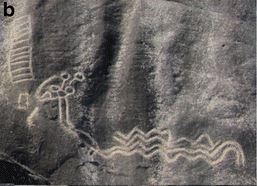20 March 2017
La Pintada landslide in Mexico: a new paper that links the slide and the cultural history
Posted by Dave Petley
La Pintada landslide in Mexico: a new paper that links the landslide and the cultural history
In September 2013 a large landslide occurred at La Pintada in Mexico, killing 86 people. This landslide, which was triggered by Hurricane Manuel, is considered to be the worst landslide event in recent times in Mexico. I blogged about this landslide at the time, highlighting both the initial reports and the more detailed information. In a paper recently published in the journal Landslides, et al. (2017) provide a detailed description of the landslide. They have found that the landslide had a volume of about 125,000 m3 and occurred on a slope with a long history of instability. The local community is considered to have a high level of social exclusion; the majority of the population had not completed primary school and had no access to health services. Almost 12% had no toilet facilities. Thus, this was a community with a high level of vulnerability to natural hazards.
Google Earth has a decent image of the aftermath of the landslide and the extensive work that has been undertaken on both the slope and to rebuild the community:

Google Earth image of the La Pintada landslide site
.
But the most interesting aspect of the paper is an analysis of the cultural history of the area in relation to landslides. In the paper, et al. (2017) note that the La Pintada slide was a reactivation of an ancient landslide complex, with a likely movement event in the 1940s but a history that extends back much further. The name La Pintada means graffiti, deriving from the presence in the village of a large boulder (which itself is probably derived from an earlier landslide) that bears several petroglyths (images carved on the rock). et al. (2017) describe these carvings as follows:
The repertoire of representations of the petroglyphs is reduced to a set of repetitive geometric forms mainly circles with different designs (concentric, connected with lines and divided with internal radial lines), rectangles with inner divisions, joined ellipses, networks and parallel wavy lines. There is only one figurative element, a zoomorph motive seen in profile: Its body is formed by wavy lines that connect to an ovoid head containing an eye, mouth and a pair of antennas topped with a circle, apparently a horned snake.
This for example is the animal described above, taken from the paper:

The figurative element – a horned snake – at La Pintada, from et al. (2017)
.
et al. (2017) note that the circles and wavy lines are generally considered to represent water, whilst the horned snake is likely to represent an element of the landscape. In petroglyths in Mexico the snake is known to represent water, or to represent the processes that cause catastrophic flows in steep catchments (i.e. debris flows). There is extensive documentation that in Latin America the snake can represent landslides as well, for example:
For the Chortí people of Guatemala, chicchanes are divinities who can appear as humans, huge snakes or in a form that is half human and half feathered serpent. At the beginning of the rainy season, the chicchanes, in the form of snakes, descend from the hills and enter watercourses, driving up their volume by water displacement. If many chicchanes swim downstream at the same time, the waters overflow and cause flooding. If a chicchan leaves a river and moves by land to reach another stream, her long body, snaking down the slopes of the hills, rolls away rocks and mud downslope, causing landslides (Wisdom 1961).
Thus, et al. (2017) suggest that the ancient carvings on the landslide generated boulder at La Pintada may represent previous landslide events that have affected this community.
Reference
Alcántara-Ayala, I., Garnica-Peña, R.J., Domínguez-Morales, L. et al. (2017). The La Pintada landslide, Guerrero, Mexico: hints from the Pre-Classic to the disasters of modern times. Landslides. doi:10.1007/s10346-017-0808-9


 Dave Petley is the Vice-Chancellor of the University of Hull in the United Kingdom. His blog provides commentary and analysis of landslide events occurring worldwide, including the landslides themselves, latest research, and conferences and meetings.
Dave Petley is the Vice-Chancellor of the University of Hull in the United Kingdom. His blog provides commentary and analysis of landslide events occurring worldwide, including the landslides themselves, latest research, and conferences and meetings.